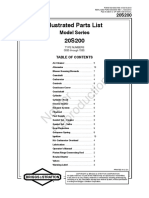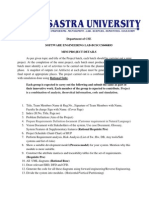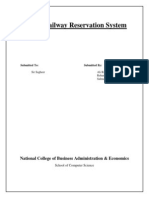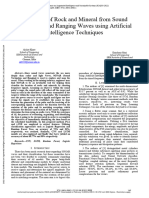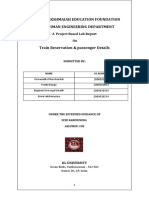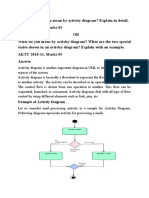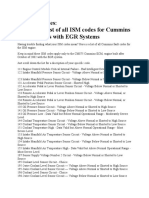1.1 Project Overview: Railway Reservation System
1.1 Project Overview: Railway Reservation System
Uploaded by
MelvinCopyright:
Available Formats
1.1 Project Overview: Railway Reservation System
1.1 Project Overview: Railway Reservation System
Uploaded by
MelvinOriginal Description:
Original Title
Copyright
Available Formats
Share this document
Did you find this document useful?
Is this content inappropriate?
Copyright:
Available Formats
1.1 Project Overview: Railway Reservation System
1.1 Project Overview: Railway Reservation System
Uploaded by
MelvinCopyright:
Available Formats
RAILWAY RESERVATION SYSTEM
CHAPTER 1
INTRODUCTION
India is the 7th largest country in terms of geographical size. This means there is a need
for efficient means for long distance transportation. The long distance road network is
very poorly developed in most parts of India. Bulk of long distance traffic is carried by
the Indian Railway as a result Indian railways. Therefore, forms a backbone of public
transport in India. The efficiency of the railway will increase result of computerization
due to dramatic reduction in communication time among geographically dispersed
offices. For the reservation of the ticket a person goes to ticket counter of the railway
reservation office and expend its valuable time in standing queue. Now to save that time
we have a facility of Online Reservation now we can book cancel or search other train
information just by click on computer.
1.1 PROJECT OVERVIEW
This project will give us the information about railway reservation. This system is
basically concerned with the reservation and cancellation of railway tickets to the
passengers. To be more specific, our system is limited in such a way that a train starting
from a particular source will have a single destination. The basic functions being
performed by our system are reservation and cancellation.
Customers can find the proper and correct information about the railway and shows the
It reserves and cancels seats for the passenger.
It contains information about the trains.
It contains information about the Seat Availability.
Railway time table.
Reservation Possibilities.
Train Ticket booking.
Booked Railway Ticket Status.
Train between stations.
DEPT. OF CSE | BTLITM Page 1
RAILWAY RESERVATION SYSTEM
1.2 NEED OF THIS SYSTEM
To reduce complexity of existing system.
Effective management of time.
To make work easy, simple and error free.
Effective utilization of available resource.
To enhance the efficiency and diversification of services activities.
User friendly.
Interactive graphical user interface.
The scope of project defines the project feasibility the technology, finance, time and
resources best define in technology weather the defects can be reduced in the project and
up which level financially, weather the overall project cost is affordable. Time describe
the weather the projection finishing point will be achieved on time or before time
resources required should be available at the rate of cost and time.
DEPT. OF CSE | BTLITM Page 2
RAILWAY RESERVATION SYSTEM
CHAPTER 2
LITERATURE SURVEY
2.1 EXISTING SYSTEM
In the existing system exams are done only manually but in proposed system we have to
computerize the exams using this application. The existing system has the following
problems:
Lack of security of data.
More man power.
Time consuming.
Consumes large volume of pare work.
Needs manual calculations.
No direct role for the higher officials.
2.2 PROPOSED SYSTEM
The aim of propose system is to develop a system of improved facilities. The proposed
system can overcome all the limitations of the existing system. The system provides he
following services:
Security of data.
Ensure data accuracy.
Proper control of the higher officials.
Minimize manual data entry.
Minimum time is needed for various processes.
Greater efficiency.
Better service.
User friendliness and interactive.
DEPT. OF CSE | BTLITM Page 3
RAILWAY RESERVATION SYSTEM
2.3 FEASIBILITY STUDY
The feasibility study is the important step in any system development process. Because it
makes analysis of different aspects like cost required for developing and executing the
system, the time required for each stage of the system. If these important factors are not
analysed then definitely it would be a total failure. So for running the application and the
organization successfully this step is a very important step in a software development
lifecycle process.
There are three types of feasibility analysis:
Operational feasibility
Technical feasibility
Economical/financial feasibility
2.3.1 OPERATIONAL FEASIBILITY
Operational feasibility measures how well the solution will work in the organization and
how will end-user and management feels about the system. Proposed system is helpful for
all the users associated with the organization. It will allow the administrator to have up-
to-date information regarding all the aspects of their users, the decision-making process
will also become faster with the use of data integration, consolidation. So it is feasible to
implement the system.
2.3.2 TECHNICAL FEASIBILITY
This involves questions such as whether the technology needed for the system exists, how
difficult it will be to build, and whether the firm has enough experience using that
technology. This system required minimum hardware equipment to run efficiently.
2.3.3 ECONOMICAL FEASIBILITY
Economically to find out whether this project is economically feasible or not for that used
feasibility analyses. In this stage list direct costs or indirect costs associated with the
project.
DEPT. OF CSE | BTLITM Page 4
RAILWAY RESERVATION SYSTEM
2.4 OBJECTIVES
The objective of this project is to provide tickets to public in the comforts to their home or
residence and to save them from hassles to visit ‘Railway Reservation Centres’. By doing
this, we are not only saving time of public but also saving their cost of traveling or
parking to these centres. For Railways it is saving on their infrastructure i.e. Buildings,
Air-Conditioning, Electricity, Furniture, Staff etc.
DEPT. OF CSE | BTLITM Page 5
RAILWAY RESERVATION SYSTEM
CHAPTER 3
SYSTEM REQUIREMENTS AND SPECIFICATION
3.1 REQUIREMENTS SPECIFICATION
A Software Requirements Specification (SRS) is a complete description of the behaviour
of the system to be developed. It includes a set of use case that describes all the
interactions that the users will have with the software. Use cases are also known as
Functional Requirements. Non-Functional Requirements are requirements which
impose constraints on the design or implementation (such as performance requirements,
quality standards, or design constraints).
3.1.1 FUNCTIONAL REQUIREMENTS
In software engineering, a functional requirement defines a function of a software-system
or component. A function is described as a set of inputs, the behaviour and outputs.
Functional requirements may be calculations, technical details, data manipulation and
processing and other specific functionality that show how a use case to be fulfilled.
Typically, a requirements analyst generates functional requirements after building use
cases. However, this may have exceptions since software development is an iterative
process and sometime certain requirements are conceived prior to the definition of the
use case. Both artefacts (use cases documents and requirements documents) complement
each other in a bidirectional process. A typical functional requirement will contain a
unique name and number, a brief summary, and a rationale. This information is used to
help the reader understand why the requirement is needed, and to track the requirement
through the development of the system. The core of the requirement is the description of
the required behaviour, which must be a clear and readable description of the required
behaviour. This behaviour may come from organizational or business rule, or it may be
discovered through elicitation sessions with users, stakeholders and other experts within
the organization. Software requirements must be clear, correct unambiguous, specific and
verifiable.
DEPT. OF CSE | BTLITM Page 6
RAILWAY RESERVATION SYSTEM
Purpose a description of the functional requirement its reason(s).
what are the input; in what form will they arrive; from what sources
Inputs
can the input come; what are the legal domains of each input.
Describes the outcome rather than the implementation; includes any
Processing validity checks on the data, exact timing of each operation (if
needed), how to handle unexpected or abnormal situations.
The form, shape, description and volume of output; output timing;
range of parameters in the output; unit measure of the output;
Outputs
process by which the output is stored or destroyed; process for
handling error message produced as output.
Table 3.1 Functional Requirements
3.1.2 NON-FUNCTIONAL REQUIREMENTS
In systems engineering and requirements engineering, non-functional requirements are
requirements which specify criteria that can be used to judge the operation of system,
rather than specific behaviours. Non-functional requirements are often called qualities of
a system. Other terms for non-functional requirements are “constraints”, “quality
attributes”, “quality goals” and “quality of service requirements”. Qualities, i.e. non-
functional requirements can be divided into 2 main categories:
Execution qualities, such as security and usability, are observable at runtime.
Evolution qualities, such as extensibility and scalability, embody in the static
structure of the software system.
Time The project should be completed within the stipulated time period.
Cost The cost involved in marketing the project should be less.
Usability This requirement is present, as this system will interact with user.
Reliability This system must be highly robust.
Performance It should be fast enough to produce the output.
Table 3.2 Non-functional Requirements
DEPT. OF CSE | BTLITM Page 7
RAILWAY RESERVATION SYSTEM
3.2 HARDWARE REQUIREMENTS
Main Memory : 256MB
Micro Processor : Pentium-III, intel core-2-duo, i3, i5, i7
Hard Disk Drive : 4.3 GB.
Cache Memory : 512KB.
3.3 SOFTWARE REQUIREMENTS
Operating System : Windows 98/NT, Windows 7, 8, 10
Front End : PHP
Back End : MySQL Server
DEPT. OF CSE | BTLITM Page 8
RAILWAY RESERVATION SYSTEM
CHAPTER 4
SYSTEM DESIGN
4.1 DATA FLOW DIAGRAM
4.1.1 LEVEL 1 DFD
Fig. 4.1 Level 1 DFD of ORRS
4.1.2 LEVEL 2 DFD
Fig. 4.2 Level 2 DFD of ORRS
DEPT. OF CSE | BTLITM Page 9
RAILWAY RESERVATION SYSTEM
4.2 ER DIAGRAM
Fig. 4.3 ER Diagram of ORRS
4.3 SCHEMA
Fig. 4.4 Schema of ORRS
DEPT. OF CSE | BTLITM Page 10
RAILWAY RESERVATION SYSTEM
CHAPTER 5
SYSTEM TESTING
5.1 TESTING
Software testing is a critical phase of software quality assurance. It indicates the ultimate
review of specification, design and code generation. Once source code has been
generated, software must be tested to uncover and correct maximum possible errors,
before being delivered. Testing emphasizes on a set of methods for the creation of test
cases that fulfil overall testing objectives.
The primary objectives of software testing are as follows:
Testing is a process of executing a program to find an error in it.
A good test case should have a high probability of finding an as yet-undiscovered
error.
A test case will be considered successful if it uncovers an as-yet undiscovered
error.
5.2 TESTING USED IN THIS PROJECT
5.2.1 UNIT TESTING
Unit testing aims the verification effort on the smallest unit of software design i.e., a
software component or module. It uses procedural design as a guide to test major control
paths and uncover errors within the module boundary. It is a White box oriented and the
step can be conducted in parallel for multiple components.
Unit testing is a dynamic method for verification, where the program is actually compiled
and executed. It is one of the most widely used methods, and the coding phase is
sometimes called “coding and unit testing phase”. The goal of unit testing is to test
modules or “units”, not the whole software system. Unit testing is most often done by the
programmer himself/herself. The goal of Unit testing is to isolate each part of the
program and show that the individual parts are correct. A unit test provides a strict,
written contract that the piece of code must satisfy. As a result, it affords several benefits.
DEPT. OF CSE | BTLITM Page 11
RAILWAY RESERVATION SYSTEM
5.2.2 INTEGRATION TESTING
Integration testing is a phase of software testing in which individual software modules are
combined and tested as a group. It follows snit testing and precedes system testing. The
major objective of integration testing is to tackle the problem of integration i.e. putting all
the modules together. One module can have an inadvertent, adverse effect on another, sub
functions, when combined, may not be magnified to unacceptable levels; global data
structure can cause problems and to truncate this list of problems we use integration
testing.
Integration testing strategy used is Bottom-Up Integration Testing. In it all the bottom or
low level modules, procedures or functions are integrated and then tested. After the
integration testing of lower level integration modules, the next level of modules will be
formed and can be used for integration testing. This approach is helpful only when all or
most of the modules of the same development level are ready. This method helps to
determine the levels of software development and makes easier to report testing progress
in the form of a percentage.
5.2.3 VALIDATION TESTING
At the climax of integration testing, software is developed as a package having all the
errors uncovered and corrected. At this time, a final series of software test May be in
process. It is called validation testing. Validation succeeds when software function in a
reasonably expectable manner. Validation attempts to uncover errors, but the emphasis is
on the requirements level i.e. the things that will be immediately apparent to the
customer.
DEPT. OF CSE | BTLITM Page 12
RAILWAY RESERVATION SYSTEM
CHAPTER 6
RESULTS AND DISCUSSION
6.1 ORRS HOME PAGE
Fig. 6.1 ORRS Home Page
6.2 ADMIN LOGIN PAGE
Fig. 6.2 Admin Login Page
DEPT. OF CSE | BTLITM Page 13
RAILWAY RESERVATION SYSTEM
6.3 RESERVATION SCHEDULE PAGE
Fig. 6.3 Reservation Schedule Page
6.4 ACCOMODATION SETTING PAGE
Fig. 6.4 Accommodation Setting Page
DEPT. OF CSE | BTLITM Page 14
RAILWAY RESERVATION SYSTEM
6.5 PASSENGER INFORMATION PAGE
Fig. 6.5 Passenger Information Page
6.6 RESERVATION CONFIRMATION PROMPT
Fig. 6.6 Reservation Confirmation Prompt
DEPT. OF CSE | BTLITM Page 15
RAILWAY RESERVATION SYSTEM
6.7 PAYMENT INFORMATION PAGE
Fig. 6.7 Payment Information Page
6.8 RESERVATION LISTING FOR ADMIN
Fig. 6.8 Reservation Listing for Admin
DEPT. OF CSE | BTLITM Page 16
RAILWAY RESERVATION SYSTEM
6.9 ACCEPTING PAYMENT FOR RESERVATION
Fig. 6.9 Accepting Payment for Reservation
6.10 TRANSACTION SAVED PROMPT
Fig. 6.10 Transaction Saved Prompt
DEPT. OF CSE | BTLITM Page 17
RAILWAY RESERVATION SYSTEM
6.11 TRANSACTION LISTING FOR ADMIN
Fig. 6.11 Transaction Listing for Admin
DEPT. OF CSE | BTLITM Page 18
RAILWAY RESERVATION SYSTEM
CONCLUSION
Rather than designing manually we have made use of computer as once that data’s are
input it performs accurate function. There is no chance of fault or miscalculation if the
data are fed correctly. Use of the computers has solved many problems, which are faced
while manual calculation. This is not the end but beginning of the versatile, efficient and
outsourcing railway reservation system. This is the one which is compatible to all
operating system. By making this we project we made a small footstep towards the path
of progress of platform independent railway reservation system.
DEPT. OF CSE | BTLITM Page 19
RAILWAY RESERVATION SYSTEM
BIBLIOGRAPHY
[1]. Database systems Models, Languages, Design and Application Programming,
RamezElmasri and Shamkant B. Navathe, 7th Edition, 2017, Pearson.
[2]. Database management systems, Ramakrishnan, and Gehrke, 3rd Edition, 2014,
McGraw Hill.
[3]. Silberschatz Korth and Sudharshan, Database System Concepts, 6th Edition, Mc
GrawHill, 2013.
[4]. Coronel, Morris, and Rob, Database Principles Fundamentals of Design,
Implementation and Management, Cengage Learning 2012.
[5]. Agrawal,V. 2004. Managing Indian Railways, New Delhi, Manas Publications.
[6]. Edvardsson, B. 2006. Service quality: beyond cognitive assessment. Managing
Service Quality, 15(2): 127-131.
[7]. Gremler, DD. 2004. The critical incident technique in service research. Journal of
Service Research, 7(1): 65-89.
DEPT. OF CSE | BTLITM Page 20
You might also like
- Briggs and Stratton Engine Manual PDFDocument16 pagesBriggs and Stratton Engine Manual PDFChetan100% (3)
- Airline Reservation Systems ADocument4 pagesAirline Reservation Systems AMuhammad Kashif Saeed AnsariNo ratings yet
- A330 System ManualDocument93 pagesA330 System ManualCdr. Pearl86% (29)
- Hostel Management System Presentation Show - PPSXDocument26 pagesHostel Management System Presentation Show - PPSXUdayanath Bag100% (2)
- News Paper Agency SystemDocument29 pagesNews Paper Agency Systemshrankhlasingh0% (1)
- Railway Reservation System: Software Requirements SpecificationDocument19 pagesRailway Reservation System: Software Requirements SpecificationsarthakNo ratings yet
- Hostel ManagementDocument20 pagesHostel ManagementSahil KumarNo ratings yet
- Mini Project GuidelineDocument2 pagesMini Project GuidelineKavin CavinNo ratings yet
- Class 12 Python Project TypingDocument21 pagesClass 12 Python Project TypingSUPPORT CARRYMINATINo ratings yet
- Student ManagementDocument44 pagesStudent ManagementTamilnaduNo ratings yet
- College Bus Final ReportDocument37 pagesCollege Bus Final ReportWasim KhanNo ratings yet
- Railway Reservation System ProjectDocument18 pagesRailway Reservation System ProjectPiyush GaurNo ratings yet
- Online Rto Management System PDFDocument87 pagesOnline Rto Management System PDFAjit More100% (3)
- Online Quiz System ProjectDocument18 pagesOnline Quiz System ProjectNitin Nilesh0% (4)
- Railway Reservation SystemDocument15 pagesRailway Reservation Systemchithambaramani0% (1)
- Railway Reservation Oops ProjectDocument24 pagesRailway Reservation Oops ProjectShamil IqbalNo ratings yet
- Java Mini Project ReportDocument15 pagesJava Mini Project ReportChandana KlNo ratings yet
- Problem: Currency Conversion Description: The Currency Conversion Application Is A Menu-Driven Program That AllowsDocument12 pagesProblem: Currency Conversion Description: The Currency Conversion Application Is A Menu-Driven Program That AllowsDavid Suresh0% (2)
- Bus TicketDocument62 pagesBus Ticketmansha99No ratings yet
- Fdocuments - in - Online Quiz System ProjectDocument17 pagesFdocuments - in - Online Quiz System ProjectAman KumarNo ratings yet
- College Management SystemDocument8 pagesCollege Management SystemSunil Sharma50% (2)
- Railway Tracking and Arrival Time PredictionDocument3 pagesRailway Tracking and Arrival Time PredictionSumit TripathiNo ratings yet
- Project Report 4th SemDocument21 pagesProject Report 4th Semshiv.regkec-991-21No ratings yet
- Visvesvaraya Technological University Jnanasangama, Belagavi - 590018Document30 pagesVisvesvaraya Technological University Jnanasangama, Belagavi - 590018Ravi ShankarNo ratings yet
- Movie Ticket BookingDocument29 pagesMovie Ticket BookingAslam BashaNo ratings yet
- Faculty Management Final ReportDocument44 pagesFaculty Management Final ReportBahubali Hattiholi100% (1)
- Project Report Text Editor in JavaDocument10 pagesProject Report Text Editor in JavaKuldeep Sharma100% (1)
- Snake Game ReportDocument55 pagesSnake Game Reportm8621115No ratings yet
- Railway Reservation SystemDocument20 pagesRailway Reservation SystemAkshat Kale67% (6)
- SRM Mess Management SystemDocument18 pagesSRM Mess Management SystemSahithya Akula AP21110011110No ratings yet
- Photo LabDocument70 pagesPhoto Labmansha99100% (1)
- CodeKul PVT LTD Final ReportDocument9 pagesCodeKul PVT LTD Final ReportYASH TAMBATKAR100% (1)
- ProjectDocument10 pagesProjectabdul basit100% (1)
- Ngo1 WDocument15 pagesNgo1 WDev Kumar SharmaNo ratings yet
- Railway Reservation SystemDocument11 pagesRailway Reservation SystemSalman Karim50% (2)
- E MartDocument7 pagesE MartAkash SaxenaNo ratings yet
- Prediction of Rock and Mineral From Sound Navigation and Ranging Waves Using Artificial Intelligence TechniquesDocument8 pagesPrediction of Rock and Mineral From Sound Navigation and Ranging Waves Using Artificial Intelligence TechniquesNitin Kumar GuptaNo ratings yet
- Micro Project: Maharashtra State Board of Technical EducationDocument15 pagesMicro Project: Maharashtra State Board of Technical EducationYogesh Raut100% (1)
- Tour and Travel Management System Synopsis MainDocument9 pagesTour and Travel Management System Synopsis MainRoshan JadhavNo ratings yet
- Complete Contact Book SynopsisDocument25 pagesComplete Contact Book Synopsisvdreams13No ratings yet
- Student Result Management System Project Reportdocx 3 PDF FreeDocument49 pagesStudent Result Management System Project Reportdocx 3 PDF FreeSagar ChauhanNo ratings yet
- Bank Management System-ProjectDocument35 pagesBank Management System-ProjectJyoti SahuNo ratings yet
- MAD Microproject ReportDocument14 pagesMAD Microproject Reportsanket0130100% (1)
- Project 1Document16 pagesProject 1tawfeeq ryukNo ratings yet
- Dot Net FrameworkDocument31 pagesDot Net Frameworkomshewale20195100% (1)
- Summer Training Report: Bachelor of TechnologyDocument37 pagesSummer Training Report: Bachelor of TechnologyviveshNo ratings yet
- Stock Management SynopsisDocument2 pagesStock Management SynopsisAnonymous m46I3FXO7575% (4)
- Project Synopsis For ChatbotDocument5 pagesProject Synopsis For ChatbotBibek BcNo ratings yet
- Koneru Lakshmaiah Education Foundation Freshman Engineering DepartmentDocument20 pagesKoneru Lakshmaiah Education Foundation Freshman Engineering Departmentyaswanth ram100% (1)
- Examination System OnlineDocument108 pagesExamination System OnlineRuthvik ReddyNo ratings yet
- 1 Software Engineering Virtual LabDocument4 pages1 Software Engineering Virtual Labprince_kc2002No ratings yet
- WTA Mini Project FormatDocument21 pagesWTA Mini Project FormatIfra100% (3)
- Online Hotel Booking System 1Document9 pagesOnline Hotel Booking System 1EESHA AGARWALNo ratings yet
- Preshcool SynopsisDocument4 pagesPreshcool SynopsisMEGHANo ratings yet
- Result Management SystemDocument11 pagesResult Management SystemManmeet RajputNo ratings yet
- Index: 1.1 Key FeaturesDocument53 pagesIndex: 1.1 Key FeaturesPallavi PalluNo ratings yet
- Attendence Management System (JAVA)Document16 pagesAttendence Management System (JAVA)tirth.patel2005aaNo ratings yet
- Airline Reservation System Project Report inDocument76 pagesAirline Reservation System Project Report inSharma Nishant50% (2)
- SD Exp2 - 13 - b3Document34 pagesSD Exp2 - 13 - b3MIHIR PATELNo ratings yet
- On Line Railway Reservation SystemDocument13 pagesOn Line Railway Reservation SystemU18CSD016No ratings yet
- Srs RailwaysDocument23 pagesSrs Railwaysherikow431No ratings yet
- PerkinsDocument2 pagesPerkinsMARKETING JANo ratings yet
- 2nd Assignments Withs AnswersDocument34 pages2nd Assignments Withs AnswersAnas SiddiquiNo ratings yet
- API Automation Testing Training SyllabusDocument5 pagesAPI Automation Testing Training SyllabusRodiNo ratings yet
- Unit.3 Web Programming With V.BDocument76 pagesUnit.3 Web Programming With V.BAdinathNo ratings yet
- Match The Terms Wish The DefinitionDocument1 pageMatch The Terms Wish The DefinitionLasagna OoooNo ratings yet
- UNIT-I Introduction and Syntax of Python ProgramDocument17 pagesUNIT-I Introduction and Syntax of Python Programumeshsabale.2006No ratings yet
- ISB Fault Codes: A Complete List of All ISM Codes For Cummins Diesel Engines With EGR SystemsDocument5 pagesISB Fault Codes: A Complete List of All ISM Codes For Cummins Diesel Engines With EGR SystemsEduardo TorresNo ratings yet
- Core JAVADocument182 pagesCore JAVAVijaya BottaNo ratings yet
- Leica GS18 DSDocument2 pagesLeica GS18 DSCRV2011No ratings yet
- Web Engineering: CIS 376 Bruce R. Maxim UM-DearbornDocument14 pagesWeb Engineering: CIS 376 Bruce R. Maxim UM-DearbornbhimavadNo ratings yet
- Summary of It Client Interview 1Document4 pagesSummary of It Client Interview 1Derick cheruyotNo ratings yet
- Mechanical Project On ValveDocument48 pagesMechanical Project On ValveSHAHA TVNo ratings yet
- Shoe Billing ProjectDocument26 pagesShoe Billing ProjectManav KumarNo ratings yet
- Student Information SystemDocument23 pagesStudent Information SystemSija M ThomasNo ratings yet
- IT MisDocument1 pageIT MisSh AvyNo ratings yet
- Data ContainerDocument24 pagesData Containersoftware.eng.2011No ratings yet
- CPT202 Assignment 2 Group ReportDocument11 pagesCPT202 Assignment 2 Group Reportxiaohan zhangNo ratings yet
- Unidad 1pr EdDocument1 pageUnidad 1pr EdOlexNo ratings yet
- Digital Control SystemDocument2 pagesDigital Control SystemJänMënärd Dônqûîllô Ōrāyē SāngālNo ratings yet
- Tech M - F2F QtnsDocument3 pagesTech M - F2F Qtnsxalon35778No ratings yet
- Interacting Alicloud - MDDocument8 pagesInteracting Alicloud - MDmy myNo ratings yet
- Art Gallery DocumentationDocument55 pagesArt Gallery DocumentationJayapriya Philip67% (9)
- Jadual Penjajaran MasaDocument15 pagesJadual Penjajaran MasaMels BNo ratings yet
- Object Oriented Programming 600206 P.NITHYANANDAM. Asst - ProfessorDocument476 pagesObject Oriented Programming 600206 P.NITHYANANDAM. Asst - ProfessorVignesh WikiNo ratings yet
- Testing Implementation: Click To Edit Master Subtitle StyleDocument8 pagesTesting Implementation: Click To Edit Master Subtitle StylespongechieNo ratings yet
- Java TheoryDocument10 pagesJava TheoryAvik BachharNo ratings yet
- Software Development ProcessDocument2 pagesSoftware Development ProcessUppamjot SinghNo ratings yet
- Service Checks and Adjustments: Telephone: Fax: VAT Registration No.Document2 pagesService Checks and Adjustments: Telephone: Fax: VAT Registration No.Adrian MacayaNo ratings yet
